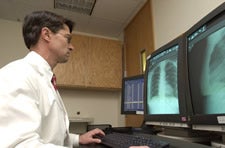Integration efforts rank University Health Systems in top 100
GREENVILLE, N.C. (Feb. 23, 2004) — University Health Systems of Eastern Carolina has been ranked among the nation’s top 100 health systems in terms of integrating clinical information to improve patient care as well as financial information and technology to improve efficiency.
UHS ranked 86th in the seventh-annual ranking of health systems integration by Verispan, a health care research firm based in Yardley, Pa. The rankings were released last week.

Dr. Julian Vainright, chief of radiology services at Pitt County Memorial Hospital, examines images transmitted through the picture archiving and communications system. Such technology is one reason University Health Systems ranks among the most integrate
“Once again, the UHS family is pleased to be recognized by yet another nationally respected health care ranking firm,” said Dave McRae, chief executive officer of UHS. “These public notifications affirm the hard work of our health system and its employees and physicians to improve the health care of eastern Carolina.”
Verispan looked at the country’s 568 regional non-specialty health care systems and rated each one on clinical and financial performance. It also measured the degree of integration in several categories, including access, contract capabilities, hospital use, services and technology. Verispan has conducted the annual ranking for seven years. UHS was one of 15 systems to make the top 100 for the first time.
Other N.C. health systems that made the list are Carolinas HealthCare System of Charlotte, ranked 37th, and Novant Health of Winston-Salem, ranked 55th. The top health system on the list was Intermountain Health Care of Salt Lake City.
Networks ranked in the top 100 have better profit margins, higher patient volumes and shorter lengths of stay than the 468 systems that don’t appear on the list, Verispan said. For example, profit margins averaged 3.4 percent for systems on the list, compared with a 2 percent average for other systems. Average length of stay at the hospitals in the ranked systems was 5.13 days versus 6.06 for systems not on the list. A shorter length of stay reflects efficient care management and resource use, helping to lower costs for patients and the health system.
Verispan also found that integrated health care networks continue to broaden their scope by partnering with hospitals, medical practices, nursing homes and other providers rather than acquiring organizations.
More systems also apparently want to fill the need for long-term-care and home health services, according to Verispan. The percentage of U.S. nursing homes that are affiliated with a health system grew from 5.9 percent a year ago to 8.2 percent, Verispan said. The percentage of home health agencies that belong to networks also edged higher, to more than 10 percent.
UHS matches the trends Verispan noted. The system recorded a 3 percent operating margin in fiscal year 2003 and an average length of stay of 5.31 days. The system also has a home-health agency, University Home Care, and operates long-term care beds at Chowan Hospital in Edenton. In addition, UHS employs 21 physicians practicing at 13 sites in northeastern North Carolina and on the Outer Banks. Altogether, UHS hospitals have a medical staff of approximately 800 physicians and another 272 resident physicians who are receiving their post-medical school training.
One example of integration that has benefited patients across UHS is the picture archiving and communications system, or PACS, that allows radiologists in Greenville to interpret images taken of patients at any UHS facility. Because PACS is digital, film and film storage costs are eliminated and lost films are a thing of the past.
“These images can be very rapidly sent to and retrieved from any hospital or clinic site within the UHS network,” said